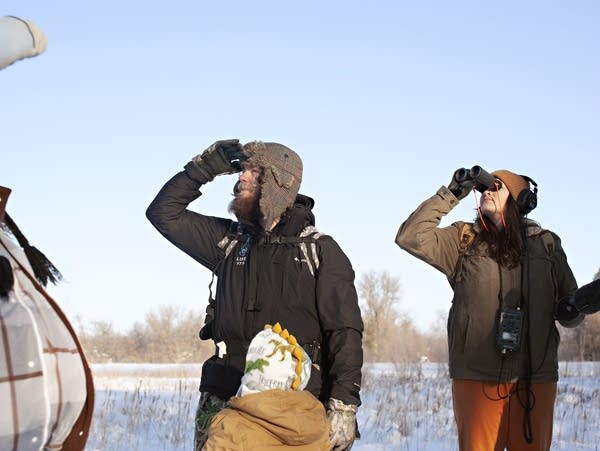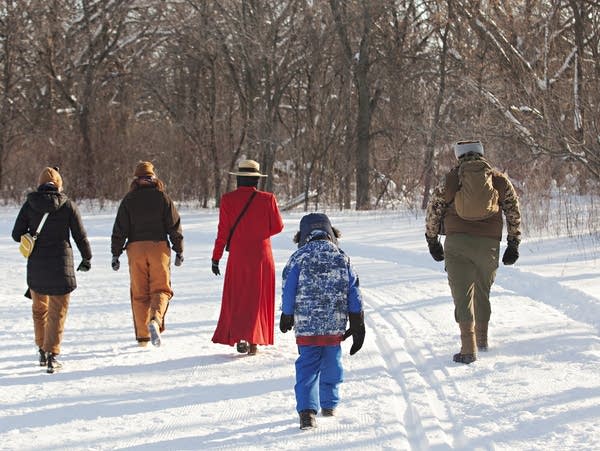Winter Play: We tried Minnesota birrrd-watching

Go Deeper.
Create an account or log in to save stories.
Like this?
Thanks for liking this story! We have added it to a list of your favorite stories.
As winter cold bites deep, MPR News is celebrating the best of the season through a new series called Winter Play. Our staff across the state set out to try a new-to-them winter pastime. Digital producer Amy Felegy tried her hand — and eyes — at cold-weather bird-watching in northwestern Minnesota.
Stop what you’re doing right now. Crack open a window or pop your head outside.
Can you hear a bird? Can you see any?
Bird-watching has become my newest itch, post-bird-watching for the first time last month. How did I go from not knowing a bird from a leaf (hey, I don’t have 20/20 vision) to finding this newfound passion?
Turn Up Your Support
MPR News helps you turn down the noise and build shared understanding. Turn up your support for this public resource and keep trusted journalism accessible to all.
Let’s enter the world of birding for a moment. Come along with me.
It’s not just for the birds
On a recent Saturday morning I wandered around Forest River Park in Fargo. It’s right across the Red River from the MPR News Moorhead bureau.
I usually take my bird sightings for granted. But not on this particular day. I was out on a winter birding outing, part of Audubon Dakota’s annual Winter Birding Festival.

Temperatures hovered around the mid-teens. Dressed in my regular winter gear, I walked around the tranquil wooded loop. While my thin gloves didn’t interfere with my binocular focusing, they did interfere with my finger warmth.
I expected to join maybe a handful of participants, but apparently winter bird-watching is popular: Audubon Dakota says about 100 folks showed up.

Volunteers divided up the crowd and led the excursion. Our group’s guide was Evalynn Trumbo, a bird researcher at North Dakota State University.
“Oh, we got a crow back that way! Those are pretty common around here. Occasionally we do have ravens as well. They’re a little bigger,” Trumbo says, pointing to a flash of black in the sky.
Crow sighting? Check. I didn’t even need my new binoculars for that guy.
‘Scavenger hunt for the mind and eye’
As we sauntered around, in silence save for the sound of boots on crunching snow, I took in the peace. Birding begun to feel like a little scavenger hunt for the mind and eye.
I thought I caught a glimpse of a woodpecker a few times, but he kept dodging from my lenses.

“The bird is juuust to the left that brown tree over there,” someone would say.
Ah, yes. That brown tree. Among all the other brown trees. Of course.
But I remained optimistic. My ears kept telling me birds were out there. I just needed my eyes to catch up.
I tried sticking out my arms Snow White-style. I whistled a little tune. Nothing.

What a creep!
Trumbo says this park is an assuredly solid area for bird-watching, even in winter. The water system, frozen or not, and tree cover — barren or not — provides great food, shelter and resting spots for birds, she says.
“Sure,” I grumble to myself. “I’ll believe it when I see it.”
Then I did!
I won’t credit my bird-calling prowess, but at that moment a brown creeper debuted. The small, brown camouflage-colored songbirds are also known as American treecreepers, and they are charming to watch.
“They also kind of behave like a nuthatch where they kind of walk up or crawl up the side of a tree,” Trumbo says, as the bird drops down seemingly from nowhere for a bite of something good hidden in the tree bark.
I saw the little creeper — a very fitting name, mind you — for maybe 10 seconds before he moved his hunt to the snow.
That was worth it right there.

‘Sky dancers’
As the morning progressed, a few things struck me:
Birding really can be for everyone. I looked around and saw college students, couples, families, in fact anyone who wanted to brave the cold for some bird beauty. This is a pastime available to anyone, anywhere and at any time of the year or day. It’s kinetic meditation.

Another observation: I’m grateful I chose a winter activity that gets me out of the house while not fearing for my life. Sorry, ice climbing fans (ahem, Dan Kraker).
If cold fingers hadn’t set in after a few hours, I definitely could have stayed out there longer.
Post-bird-watching, I even got myself a bird feeder to enjoy the flighty friends up close. I’ve also noticed myself paying attention to their songs more, the way they peep and carol for us; I have become percipient of the sky dancers.
Lesson learned: We have a built-in soundtrack for our hurried days. We just have to listen for it.

If you want to go
Where: Anywhere there are birds! This includes your backyard or local outdoor area. I went to Forest River Park in Fargo, at 224-298 Forest River Drive.
When: Volunteers with Audubon Dakota told me the spring and fall are excellent times to spot a winged wonder as they migrate. But any and all seasons — and even times of day (think owls at night) — are birding-friendly.
How long: Again, flexibility seeps in. Listen or look for birds while you’re taking out the trash. See if you sense any on a walk or hike. There’s no need to pull out all the stops and make a day of it like I did, though I would recommend going out with a guide or group your first time.
How much: We’re talkin’ free. Sure, you can splurge on a fancy pair of binoculars (mine were $60 from the local Scheels) but they’re not necessary. Truthfully, I saw more birds with my bare eyes. Add a few bucks in gas or bus money and maybe a nice new pair of warm socks and you’re set.
What to bring: Is it cheesy to say curiosity? Beyond that, here’s my recommended list when going winter birding. We’ll start with the necessary items: Warm clothes and layers, sunglasses (that white snow is bright, friends!) and a camera so you can send me photos of your adventure. Tweet me @FelegyAmy.
Optional but fun: Most any kind of binoculars or “bins” with a strap, a birding book and friends or a guide. Here’s a birder-friendly binocular guide.
Pro tips: Listen for birds first. Then look. Log which birds you find so you can become a brainiac on them later. Use apps and websites: My guide recommended eBird for tracking sightings and BirdCast to find migration patterns.
Happy birding!


